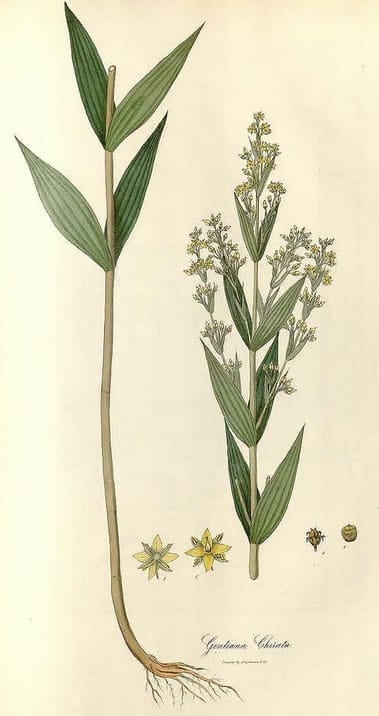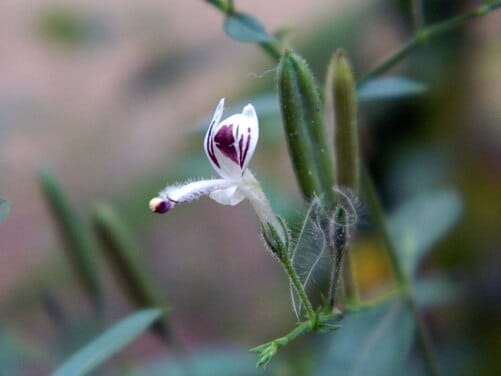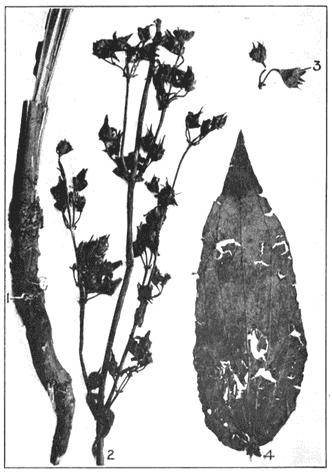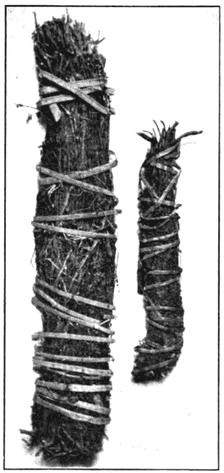Swertia, ChirettaChiretta, SwertiaKirata, Katutikta (Ayurveda) Tig Ta ཏིག་ཏ (Tibetan) Chiraita (Unani); Qasab al-dhariarah (Avicenna) |

|
 Swertia chirata
Swertia chirataWallich, Plantae Asiaticae Rariores, vol. 3: 1832
 Swertia chirata
Swertia chirata(Photo by Rison Thumboor) (Wikimedia)

|

|
|
1. Root. 2. Flowering and fruiting top. 3. Fruit. 4. Leaf showing characteristic venation. (Squibb’s Atlas of the Official Drugs, Mansfield, 1919) |
Swertia tied into bundles with bamboo as imported. (A Text Book of Pharmacognosy Heber Wilkinson Youngken, 1921) |
Botanical name:
Swertia spp.
Several species are used:
- S. chirata (syn. S. chirayita, S. tongluensis, Gentiana chirayita, G. chirata, Ophelia chirata) (Ayurveda, Unani, Tibetan Medicine)
- S. mileensis (TCM)
- India Swertia, S. chirata, S. racemosa (Rgya tig)
- Nepalese Swertia, S. ciliata (Bal tig)
- Tibetan Swertia, Swertia spp. (Bod tig)
Tibetan:–.S. bimaculata, S. dichotoma, S. erythrosticta, S. franchetiana, S. leducii, S. mussotii, S. nervosa, S. paniculata, S. punicea, S. speciosa, S. wardii, S. younghusbandii, S. yunnanensis
China::–S. angustifolia, S. alata, S. cincta (Sichuan and Yunnan)
Tibetan Medicine recognizes a number of varieties of Tig (a group of medicine) in addition to the above-named species:
- Genrianodes elwesii, Gentianella moorcroftiana (Zangs tig)
- Halenia elliptica, H. corniculata (Icags tig nag po)
- Saxifraga lychnitis (Gser tig mchog)
- Saxifraga umbellulata (Sum chu tig ta)
- Gentianella azurea (Zangs tig ‘dra ba’i lcags tig nag po)
- Gentianopsis barbata (Lcags tig) (in Buryat region)
- Swertia petiolata (Lcags tig dkar po)
- Swertia multicaulis (Lcags tig nag po)
Parts used:
Whole plant
Temperature & Taste:
Cold, dry. Bitter, Pungent
“Hot and dry in the second degree” (Avicenna)
Classification:
2F. PURIFYING
3B. FEBRIFUGE & ANTIPYRETIC 3H. LACTAGOGUE
TCM:
B. Clears Heat and Damp
Uses:
1. Clears Liver Heat and Damp: (Ayurveda, Tibet)
-Fever, Liver Fever; Bile Fever; Fever from derangement of Wind, Bile and Phlegm
-‘inflammatory conditions of the Stomach, Intestines and Liver’. (Avicenna)
-Liver heat disorder with red eyes, irritability
-Gall Stones and Cholecystitis, Hepatitis etc.
-Jaundice with dark colored urine (S. mileensis, Chinese Pharmacopoeia)
-Conjunctivitis associated with Liver heat; ‘Clears the Vision’ (Avicenna)
2. Clears Stomach Heat:
-Gastritis, Colitis
-Diarrhea and Dysentery.
-Hyperacidity
3. Clears Heat and Damp, Promotes Urine:
-Damp-Heat urinary disorders such as Strangury and Dysuria
-acute urinary tract infection with difficult painful urination (S. mileensis, Chinese Pharmacopoeia)
-Stones.
-Edema
4. Clears Heat, Resists Poison: (Ayurveda, Tibet, Unani)
-various types of Fever including Epidemic Fevers, Chronic Fevers and Malaria (Unani, Tibet)
-Fever caused by aggravation of all 3 Dosas (Wind/Bile/Phlegm) with sweating and thirst (Ayurveda)
-Snake Bite
-Laryngitis, Tonsillitis
-skin diseases with Heat and Redness, Itching; Scabies
-Ulcers.
-Syphilis and Gonorrhea.
–Duke listed it for Cancers of the Colon and Abdomen.
5. Benefits the Stomach, Promotes Digestion:
-low doses or short term use is good to stimulate the Stomach and Digestion, promote Appetite, and stimulate Bowel movement.
-indigestion, poor appetite and flatulence.
-Atony, Emaciation and after chronic illness when the digestion is poor to stimulate appetite and digestion.
6. Moves the Blood, Promotes Delivery:
-promotes menstruation in Amenorrhea and Dysmenorrhea
-Uterine pain (Avicenna)
-“Useful in cases of bluish discolouration of skin” (Avicenna)
-“It dissolves the swellings” (Avicenna)
-used to promote Delivery. It appears to have been as a Folk remedy for this purpose.
7. Externally:
-strong decoction is applied to all types of inflammation
-as a Folk remedy it is applied as a poultice to Paralyzed Limbs and Rheumatic swellings.
-Burns (Avicenna)
Dose:
Decoction: 5–20 grams (up to 30 grams in Ayurvedic Pharmacopoeia)
Powder: 250mg–3 grams
Tincture (1:5 in 25% alcohol): 3–10mls.
Correctives:
1. Avicenna often combined it with Celery seed.
2. As for Gentian
Substitutes:
1. Among the local species used as substitutes in Ayurveda and Tibetan Medicine are:
a. Clerodendrum inerma
b. Enicostemma littorale (syn. Exacum hyssopifolium, Adenema hyssopifolium)
c. Erythraea roxburghii
d. Exacum spp.
e. Limnanthemum cristatum (syn. Menyanthes hydrophyllum, Nymphoides hydrophyllum)
f. Limnanthemum indicum (syn. Menyanthes indicum, Nymphoides indicum)
g. Gentiana barbata (in Buryat)
h. Lomatogonium carinthiacum, L. rotatum (in Buryat)
2. Centaury and Gentian are acceptable substitutes.
3. ‘Green Chiretta’ is Andrographis which may be used synonymously.
Main Combinations:
1. Fever:
i. Swertia with Coriander (Ayurveda)
ii. Swertia with Ginger (Ayurveda)
iii. Swertia with Tinospora, Raisins, Emblic Myrobalan, Zedoary
iv. with Diarrhea, Swertia with Cyperus rotundus, Tinospora, Ginger (Chakradatta)
v. Swertia with Camphor, Nutmeg, Clove, Tabasheer, Safflower, Lesser Cardamon, Greater Cardamon, White Sandalwood, Water Buffalo horn (as in Camphor 14 of Tibetan Medicine)
vi. Chronic Fever, Lung Infection, Swertia with Tabasheer, Safflower, White Sandalwood, Picrorhiza, Adhatoda (as in Principle 8 of Tibetan Medicine)
vii. Vetiveria with Swertia, Sandalwood, Cyperus rotundus, Long Pepper, Black Pepper, Ginger (equal parts) (as in Nilavembu Kudineer of Siddha Medicine)
2. Liver Fever, Liver Trauma, Liver Pain, Blood disorders, Swertia with Bezoar, Shilajit, Safflower, Costus, Adhatoda (as in Bezoar 9 of Tibetan Medicine)
3. Hepatitis, Swertia, Celery seed with Honey (Avicenna)
4. For Bile disorders with headache, inflammation, fever, bitter taste and yellowish complexion, Swertia with Costus, Aconitum heterophyllum, Picrorhiza, Barberry (as in Swertia 8 of Tibetan Medicine)
5. Cholecystitis, early Jaundice, Hepatitis, Swertia with Picrorhiza, Barberry bark, Costus (as in Swertia 8 of Tibetan Medicine)
6. Stomach Heat, Gastritis, Colitis:
i. Swertia with Cardamon, Picrorhiza and Turmeric (Ayurveda)
ii. Swertia with Licorice, Costus
7. Thirst, Swertia, Emblic Myrobalan, Coriander, Raisin (Tibet)
8. Kidney Heat, Nephritis, Pyelonephritis, Hematuria, Kidney pain, Swertia with Chebulic Myrobalan, Safflower, Madder, Lacca, Shilajit, Juniper, Mucuna, Lesser Cardamon (as in Chebula 10 of Tibetan Medicine)
9. Strangury, difficult or painful Urination:
i. Swertia, Celery seed (Avicenna)
ii. Swertia with Tribulus, Barberry
iii. Swertia with Plantain seed
10. Menorrhagia from Heat:
i. Swertia, Barberry extract, Amaranthus spinosa (equal parts), taken with Honey and Rice rinse water.
ii. Swertia with Barberry, Cyperus rotundus, Adhatoda (Vasaka)
iii. Swertia with Red Earth
11. Uterine pain, “Oral intake of its decoction or a sitz-bath in it is useful in uteralgia.” (Avicenna)
12. Edema or Fever, Swertia with Ginger (Ayurveda)
13. Skin diseases, Swertia with Neem, Madder and Gotu Kola (Ayurveda)
14. ‘Nothing is more useful in burns than chiratta with rose oil and vinegar.’ (Avicenna)
Major Formulas:
Cowrie Ash 6 (Mgron thal drug pa) (Tibetan)
Goethite 25 (Mdung rtse nyer lnga) (Tibetan)
Great Black Combination (Sman nag chen mo) (Tibetan)
Great Decoction 25 (Thang chen nyer lnga) (Tibetan)
Safflower Supreme 7 (Gur gum mchog bdun) (Tibetan)
Swertia 5 Decoction (Tig ta lnga thang) (Tibetan)
Swertia 8 (Tig ta brgyad pa) (Tibetan)
Swertia 25 (Tig ta nyer lnga) (Tibetan)
Cautions:
1. Cold, so not suitable in cold and weak Stomach
2. Not used in Pregnancy
3. Not used in Vata/Wind conditions.
Main Preparations used:
-
Extra Info
-
History
|
‘Kirayat has long been an important article of the Hindu Materia Medica. It is mentioned by Susruta and other Sanskrit writers under the name of Kirata-tikta, which means the bitter plant of the Kiratas, an outcaste race of mountaineers in the north of India. It is also called Anarya-tikta, “the bitter plant of the non-Aryans.” Another Sanskrit name is Bhunimba, “ground-nim.” The herb is much esteemed by the Hindu physicians on account of its tonic, anthelmintic and febrifuge properties, and is prescribed in masked forms of malarial fever in which the chief symptoms are dyspepsia; it is usually combined with aromatics, such as ginger and lemon grass. It is also considered to be laxative, anthelmintic and alterative. In the Bhaishajya-ratuavali, a decoction is directed to be made of equal parts of chiretta, Tinosposa stems, raisins, emblic myrobalans and zedoary root. Chiretta is one of the 54 ingredients of the compound powder known as Sudareana churna, and it gives its name to a compound oil called Kiratadi-taila, in which it is combined with 26 other drugs, mostly aromatics and stimulants. This oil is rubbed on the body in obstinate cases of ague, causing emaciation and anaemia. (Bhaishajya-ratnavali.) Mahometan writers upon Indian drugs have identified Chiretta with the Kasab-ed-darira of the Arabs, and |
Calamus aromaticus of Dioscorides. Guibourt was also of the same opinion, but Fee and Royle dissent from it. The author of the Makhzan-el Adwiya gives at the end of his article upon Kasab-ed-darira the following short summary of the manner in which Chiretta is used by the Hindu physicians :— “They consider it to be cold and dry, light and flatulent; a remedy for colds and bilious affections, burning of the body, and the fever arising from derangement of the three humors which they call sannipat (fever with delirium).” The plant was first described by Roxburgh under the name of Gentiana Ghirayita in 1814. Ainslie notices it, and remarks that it appears to be much used in Bengal; it was probably rather a scarce drug in Southern India in his time, as he says little about it. In England it began to attract attention about the year 1829; and in 1839 was introduced into the Edinburgh Pharmacopoeia. It is now official in the British and Indian Pharmacopoeias, and is generally accepted as a valuable bitter tonic. In Western India it has a reputation as a remedy for bronchial asthma, and in some cases we have known it used with success. (Pharmacographia Indica, Dymock, 1891) |
